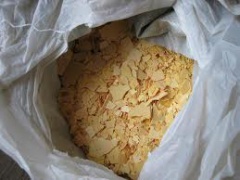Sodium sulphide
| Infobox on Sodium sulphide | |
|---|---|
| Example of Sodium sulphide |  |
| Facts | |
| Origin | - |
| Stowage factor (in m3/t) | - |
| Humidity / moisture | - |
| Ventilation | - |
| Risk factors | See text |
Sodium sulphide
Description
Sodium sulfide is the chemical compound with the formula Na2S, or more commonly its hydrate Na2S•9H2O. Both are colourless water-soluble salts that give strongly alkaline solutions. When exposed to moist air, Na2S and its hydrates emit hydrogen sulfide, which smells like rotten eggs. Some commercial samples are specified as Na2S•xH2O, where a weight percentage of Na2S is specified. Commonly available grades have around 60% Na2S by weight, which means that x is around 3. Such technical grades of sodium sulfide have a yellow appearance owing to the presence of polysulfides. These grades of sodium sulfide are marketed as 'sodium sulfide flakes'. Although the solid is yellow, solutions of it are colourless.
Application
It is primarily used in pulp and paper industry in the kraft process . It is used in water treatment as an oxygen scavenger agent and also as a metals precipitant, in the photographic industry to protect developer solutions from oxidation, in textile industry as a bleaching, as a desulfurising and as a dechlorinating agent and in leather trade for the sulfitisation of tanning extracts. It is used in chemical manufacturing as a sulfonation and sulfomethylation agent. It is used in the production of rubber chemicals, sulfur dyes and other chemical compounds. It is used in other applications including ore flotation, oil recovery, food preservative, making dyes, and detergent.
Sodium sulfide is an active ingredient in some over-the-counter ingrown toenail relief products.
Shipment / Storage / Risk factors
Yellow (or brock-red) lumps or flakes, shipped in bulk or packed in drums or barrels. On exposure, sodium sulphide undergoes a catalytic reaction and, due to the incidental chemical decomposition, the resulting product will be found to be caked, heated, of a light salmon hue tinged with slate-green patches and intermixed with splotches of some white precipitate.
In this condition, sodium sulphide is valueless as far as the textile industry is concerned. Strong irritant to skin and tissue. Flammable, dangerous and explosion risk. In solution form, sodium sulphide is corrosive.
The product is listed as dangerous cargo in the IMDG Code. Also consult the applicable MSDS sheet for safe handling advice.











